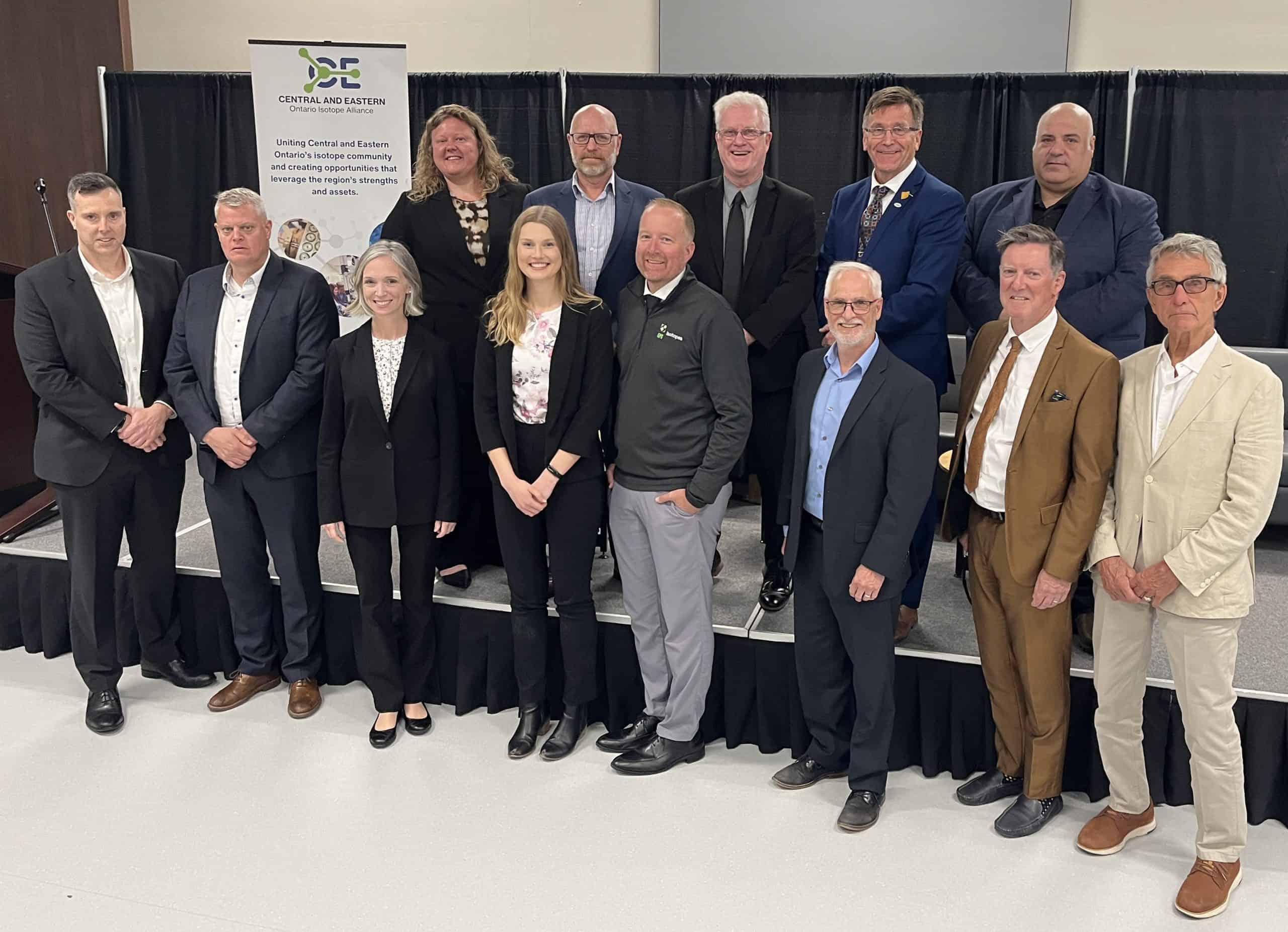Life-saving medical isotope alliance launched in Clarington
Published May 25, 2024 at 3:51 pm

The newly launched Central and Eastern Ontario Isotope Alliance (CEOIA) will increase awareness of the area’s role in producing life-saving medical isotopes and turn the province into an isotope “super power” by helping Ontario’s nuclear facilities double production over the next half-dozen years.
Canada currently produces half of the world’s supply of medical isotopes – with manufacturing centred at nuclear power plants at Darlington and Bruce – and the new alliance will support the expansion of isotope production, processing, and distribution and work to resolve challenges in medical isotope supply that affect patients fighting cancer and other diseases.
The CEOIA launched Friday at a news conference at the Garnett Rickard Recreation Complex in Bowmanville and Clarington Mayor Adrian Foster, who co-chairs the alliance, was “excited” to create “new local opportunities for economic development, job creation, research and innovation and healthcare delivery.”
“Our area is a proud host of cutting-edge technologies at every stage of the nuclear lifecycle,” he said. “This innovative partnership will leverage the expertise and assets here to advance the isotope sector and benefit the province and the country.”

Darlington Nuclear
The alliance is a joint initiative between Clarington, the Canadian Nuclear Isotope Council, Ontario Power Generation (OPG) and its subsidiary Laurentis Energy Partners, in partnership with RS McLaughlin Durham Cancer Centre in Oshawa, Actineer, Canadian Nuclear Laboratories and leaders from the isotope industry, healthcare, academia, and government.
“Bringing these groups together will help ensure the security and reliability of Canada’s isotope supply chain and position the region as a global leader in isotope innovation and production,” said Laurentis CEO Jason Van Wart, who is Foster’s co-chair on the alliance.
Laurentis will produce a nuclear medical isotope at Darlington Nuclear that will help treat liver cancer, the fourth most common cause of cancer deaths in the world. It’s estimated to affect 4,700 Canadians, with the diagnosis leading to fatalities in about three-quarters of those suffering with the disease.
Pending regulatory approvals, Laurentis expects to begin producing the isotope by mid-2025.
With a vision to double Canada’s medical isotope production by 2030, the partnership aims to grow Canada’s isotope potential to meet rising international demand. “Through industry collaboration at all levels, both regionally and nationally, Canada is one step closer to achieving this vision and improving patient access to cancer treatments,” said Canadian Nuclear Isotope Council Chair James Scongack.
Currently more than 40 per cent of all single-use medical devices produced globally are sterilized with cobalt-60 and more than 70 per cent of the world’s supply of cobalt-60 is produced at Canadian nuclear power plants.
As well, 90 per cent of the cobalt-60 market is refined here and about 60 per cent of the world’s market of iodine-125 is produced at a nuclear facility at McMaster University in Hamilton.
“Nuclear power generates more than clean reliable electricity. Isotopes harvested from Ontario’s nuclear fleet, including OPG’s Darlington and Pickering nuclear generating stations, are improving health outcomes for Canadians and patients around the world. We look forward to working with our industry, medical, municipal and other partners to further awareness and opportunities for isotopes,” said OPG Chief Nuclear Officer Steve Gregoris.
Ontario Energy Minister Todd Smith cited the extended lifespan of Pickering Nuclear, refurbishment of the Darlington plant and growth at Bruce Nuclear as reasons the province can become an isotope powerhouse on the global stage.
“With Ontario building a once-in-a-generation expansion of nuclear power, we have an opportunity to make our province an isotope superpower,” he said. “This partnership will ensure that Ontario remains in the forefront of nuclear medicine development and innovation and help us advance our position as a global leader in the production of life-saving medical isotopes.”
Cabinet colleague Sylvia Jones, Ontario’s Health Minister, said the best part of the alliance is the growing number of people fighting deadly diseases who will be helped by increased production of the isotopes.
“By working with our partners to produce medical isotopes right here in Ontario, our government is focused on ensuring that people fighting cancer and other diseases can have reliable access to the care they need, when they need it.”
The Friday afternoon launch event featured speakers talking about cutting-edge developments in the isotope industry along with a panel discussing how collaboration on medical isotopes will improve health outcomes for Canadians and patients around the world.

INdurham's Editorial Standards and Policies





